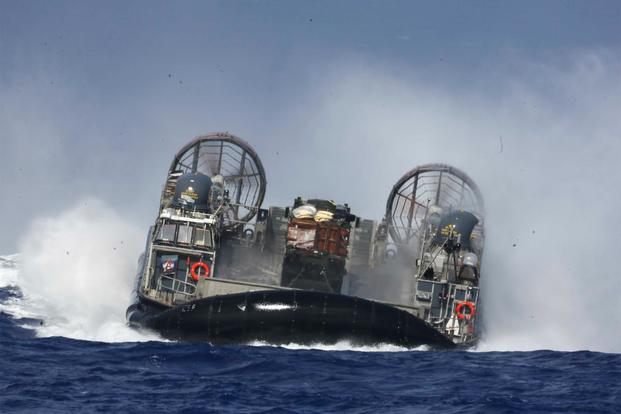NATIONAL HARBOR, Maryland -- The Marines are looking to solve a budget shortfall by trying something totally new.
The Navy's Information Warfare Research Project consortium has published a new solicitation asking industry to use advanced and innovative manufacturing technologies to develop a boat or barge that can transit from ship to shore or even from one shore to another.
"We don't have any ship-to-shore connectors coming up in the budget; they all got canceled," Maj. Matthew Friedell, a member of the Marines' Advanced Manufacturing Operations Cell, told Military.com. "So, what if the Marine Corps needs them very quickly?"
The Other Transaction Authority solicitation keeps requirements broad; Friedell said the result will likely be 40-foot ship-to-shore connectors, but the material they're made from is not specified, nor is where they're made.
"We're thinking additive [manufacturing] might be a big part of it," Friedell said, referring to a process also known as 3D printing. "But the traditional manufacturing process for making ships is pretty well proven. So we're not sure yet."
The nominee for next commandant of the Marine Corps, Lt. Gen. David Berger, has cited the Marines' need for new connectors in recent testimony on Capitol Hill, saying that the service's plan for the future fight requires investment in amphibious ships and vessels that can carry troops and gear to and from them.
"We need to fight distributed," he said. "We need connectors that we don't have right now, that will allow us to move the force from amphibious ships to the shore, spread them out shore-to-shore to the family of surface and aerial connectors. That's got to change. That's got to grow."
Friedell compared the effort to the "Higgins Boats" of the 1930s and 1940s, a commercial landing craft pursued by the Marine Corps amid frustration with the larger Navy that it was not meeting the service's small boat requirements.
"We're envisioning, if big Navy might not do this, how could we do this ourselves?" Friedell said. "How could we use advanced technologies to plug a gap that is very critical in the Marine Corps' mission?"
The solicitation calls for a rapid turnaround, with concepts submitted within 12 months. Testing with smaller-scale models will follow, then assessment of a full-sized design.
The recent effort follows a number of ambitious Marine Corps projects featuring additive manufacturing and other innovative concepts. Earlier this year, the service 3D printed a rugged concrete bridge in California -- the first of its kind in the United States.
-- Hope Hodge Seck can be reached at hope.seck@military.com. Follow her on Twitter at @HopeSeck.













